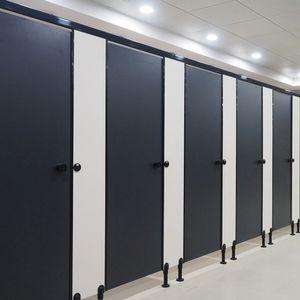
Toilet Partitions, which offer privacy and organization, are crucial parts of public restrooms. These walls are made to provide users with a safe and comfortable environment, whether they are in businesses, shopping centers, airports, or schools. Let us simplify and make it easy for you to understand everything you need to know about them.
What Are Toilet Partitions?
In public restrooms, toilet partitions are walls or dividers that divide individual toilet stalls. They keep the bathroom tidy and help keep up privacy. These walls are made to allow several places and needs because they are available in a range of sizes, styles, and materials.
Types of Toilet Partitions
Toilet partitions are typically made from several types of materials, each offering different benefits:
- Powder-Coated Steel:
- Description: Made from galvanised steel coated with a powder finish.
- Benefits: durable, affordable, and resistant to rust and corrosion.
- Common Use: Schools, offices, and public buildings.
- Plastic Laminate:
- Description: Consists of particleboard with a laminate finish.
- Benefits: Economical, available in various colors and designs.
- Common Use: low-traffic areas like small offices or shops.
- Solid Plastic (HDPE):
- Description: High-density polyethylene that is solid and durable.
- Benefits: resistant to moisture, rust, and vandalism.
- Common Use: high-traffic areas like schools, parks, and gyms.
- Stainless Steel:
- Description: Premium partitions made from stainless steel sheets.
- Benefits: Sleek appearance, high durability, and easy to clean.
- Common Use: Luxury commercial spaces, airports, and hotels.
- Solid Phenolic:
- Description: Made from layers of paper soaked in resin, compressed under high pressure.
- Benefits: waterproof, impact-resistant, and long-lasting.
- Common Use: high-humidity areas like pools, gyms, and shower rooms.
Styles of Toilet Partitions
Toilet partitions are available in various styles to meet different privacy needs:
- Overhead Braced:
- Features: Mounted to the floor with an overhead rail for support.
- Advantages: Stable and suitable for most public restrooms.
- Common Use: malls, schools, and offices.
- Floor Mounted:
- Features: Attached directly to the floor without overhead support.
- Advantages: simple installation and modern look.
- Common Use: Spaces with high ceilings.
- Ceiling Hung:
- Features: Suspended from the ceiling with no floor attachments.
- Advantages: Easy cleaning underneath and a sleek appearance.
- Common Use: high-end restrooms and areas requiring maximum floor clearance.
- Floor-to-Ceiling:
- Features: Anchored to both the floor and ceiling for maximum stability.
- Advantages: extra stability and enhanced privacy.
- Common Use: high-traffic areas needing robust partitions.
Choosing the Right Toilet Partition
Selecting the right toilet partition depends on several factors:
- Traffic Level: High-traffic areas need durable materials like solid plastic or stainless steel.
- Humidity and Moisture Exposure: In humid environments, solid phenolic or plastic partitions are ideal.
- Budget: Powder-coated steel and plastic laminate are cost-effective options.
- Aesthetics: Stainless steel and laminate offer sleek, modern designs.
Maintenance and Care
Proper maintenance ensures the longevity of toilet partitions.
- Regular Cleaning: Use mild cleaners to maintain appearance and hygiene.
- Inspect for Damage: Check hinges, locks, and panels for wear and tear.
- Avoid Harsh Chemicals: These can damage finishes, especially on laminate and powder-coated surfaces.



